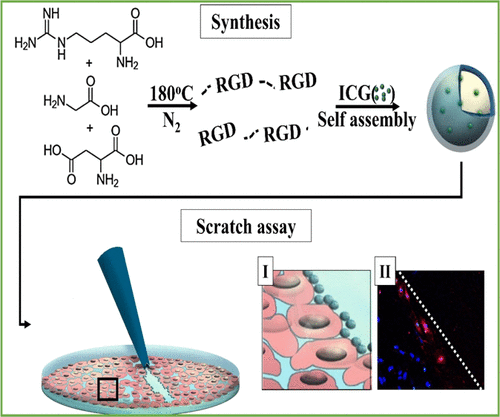Our official English website, www.x-mol.net, welcomes your
feedback! (Note: you will need to create a separate account there.)
Synthesis and Characterization of Poly(RGD) Proteinoid Polymers and NIR Fluorescent Nanoparticles of Optimal d,l-Configuration for Drug-Delivery Applications—In Vitro Study
ACS Omega ( IF 3.7 ) Pub Date : 2020-09-11 , DOI: 10.1021/acsomega.0c01916 Elad Hadad 1 , Safra Rudnick-Glick 1 , Igor Grinberg 1 , Michal Kolitz-Domb 1 , Jordan H. Chill 2 , Shlomo Margel 1
ACS Omega ( IF 3.7 ) Pub Date : 2020-09-11 , DOI: 10.1021/acsomega.0c01916 Elad Hadad 1 , Safra Rudnick-Glick 1 , Igor Grinberg 1 , Michal Kolitz-Domb 1 , Jordan H. Chill 2 , Shlomo Margel 1
Affiliation

|
RGD sequence is a tripeptide composed of three amino acids: arginine (R), glycine (G), and aspartic acid (D). The RGD peptide has a high affinity to the integrin alpha v beta 3, which is overexpressed on the membrane of many cancer cells and is attracted to areas of angiogenesis. Proteinoids are biodegradable polymers based on amino acids which are formed by bulk thermal step-growth polymerization mechanism. Hollow proteinoid nanoparticles (NPs) may be formed via self-assembly process of the proteinoid polymers. We propose using novel RGD-based proteinoid polymers to manufacture NPs in which the RGD motif is self-incorporated in the proteinoid backbone. Such P(RGD) NPs can act both as a drug carrier (by encapsulation of a desired drug) and as a targeting delivery system. This article presents the synthesis of four RGD proteinoids with different RGD optical configurations, (d) or (l) arginine, glycine, and (d) or (l) aspartic acid, in order to determine which configuration is optimal as a drug-targeting carrier. These new RGD proteinoid polymers possess high molecular weights and molecular weight monodispersity. Homonuclear nuclear magnetic resonance methods were employed to predict the expected concentration of RGD tripeptide sequence in the polymer. Near infrared fluorescent NPs have been prepared by the encapsulation of indocyanine green (ICG) dye within the different P(RGD) NPs. The dry diameters of the hollow P(RdGDd), P(RdGD), P(RGD), and P(RGDd) NPs are 55 ± 13, 48 ± 9, 45 ± 11, and 42 ± 9 nm, respectively, whereas those of the ICG-encapsulated NPs were significantly higher, 141 ± 24, 95 ± 13, 86 ± 11, and 87 ± 12 nm, respectively. The ICG-encapsulated P(RdGD) NPs exhibited higher selectivity toward epithelial injury, as demonstrated using an in vitro scratch assay, because the P(RdGD) NPs accumulated in the injured area at higher concentrations when compared to other P(RGD) NPs with different chiralities. Therefore, the P(RdGD) polymer configuration is the polymer of choice for use as a targeted drug carrier to areas of angiogenesis, such as in tumors, wounds, or cuts.
中文翻译:

药物递送应用中最佳d,l构型的聚(RGD)类蛋白聚合物和NIR荧光纳米粒子的合成与表征-体外研究
RGD序列是由三个氨基酸组成的三肽:精氨酸(R),甘氨酸(G)和天冬氨酸(D)。RGD肽对整联蛋白αv beta 3具有高度亲和力,整联蛋白αv beta 3在许多癌细胞的膜上过度表达,并被吸引至血管生成区域。类蛋白是基于氨基酸的可生物降解的聚合物,是通过本体热逐步生长聚合机理形成的。空心蛋白样纳米颗粒(NPs)可以通过类蛋白聚合物的自组装过程。我们建议使用新型的基于RGD的类蛋白聚合物来制造NP,其中RGD基序是自掺入类蛋白骨架的。此类P(RGD)NP既可以充当药物载体(通过封装所需药物),又可以充当靶向递送系统。本文介绍了具有不同RGD光学构型的四种RGD类蛋白的合成,(d)或(l)精氨酸,甘氨酸和(d)或(l(天冬氨酸),以确定哪种构型最适合作为药物靶向载体。这些新型RGD类蛋白质聚合物具有高分子量和分子量单分散性。采用同核核磁共振法预测聚合物中RGD三肽序列的预期浓度。通过将吲哚花青绿(ICG)染料封装在不同的P(RGD)NP中,可以制备近红外荧光NP。空心P(R d GD d),P(R d GD),P(RGD)和P(RGD d)的干直径)NPs分别为55±13、48±9、45±11和42±9 nm,而ICG封装的NPs明显更高,分别为141±24、95±13、86±11和87±分别为12 nm。如体外刮擦试验所示,ICG封装的P(R d GD)NPs对上皮损伤表现出更高的选择性,因为与其他P(R )相比,P(R d GD)NPs以更高的浓度积累在受伤区域。 RGD)具有不同手性的NP。因此,P(R d GD)聚合物构型是用作血管生成区域的靶向药物载体的首选聚合物,例如肿瘤,伤口或切口。
更新日期:2020-09-22
中文翻译:

药物递送应用中最佳d,l构型的聚(RGD)类蛋白聚合物和NIR荧光纳米粒子的合成与表征-体外研究
RGD序列是由三个氨基酸组成的三肽:精氨酸(R),甘氨酸(G)和天冬氨酸(D)。RGD肽对整联蛋白αv beta 3具有高度亲和力,整联蛋白αv beta 3在许多癌细胞的膜上过度表达,并被吸引至血管生成区域。类蛋白是基于氨基酸的可生物降解的聚合物,是通过本体热逐步生长聚合机理形成的。空心蛋白样纳米颗粒(NPs)可以通过类蛋白聚合物的自组装过程。我们建议使用新型的基于RGD的类蛋白聚合物来制造NP,其中RGD基序是自掺入类蛋白骨架的。此类P(RGD)NP既可以充当药物载体(通过封装所需药物),又可以充当靶向递送系统。本文介绍了具有不同RGD光学构型的四种RGD类蛋白的合成,(d)或(l)精氨酸,甘氨酸和(d)或(l(天冬氨酸),以确定哪种构型最适合作为药物靶向载体。这些新型RGD类蛋白质聚合物具有高分子量和分子量单分散性。采用同核核磁共振法预测聚合物中RGD三肽序列的预期浓度。通过将吲哚花青绿(ICG)染料封装在不同的P(RGD)NP中,可以制备近红外荧光NP。空心P(R d GD d),P(R d GD),P(RGD)和P(RGD d)的干直径)NPs分别为55±13、48±9、45±11和42±9 nm,而ICG封装的NPs明显更高,分别为141±24、95±13、86±11和87±分别为12 nm。如体外刮擦试验所示,ICG封装的P(R d GD)NPs对上皮损伤表现出更高的选择性,因为与其他P(R )相比,P(R d GD)NPs以更高的浓度积累在受伤区域。 RGD)具有不同手性的NP。因此,P(R d GD)聚合物构型是用作血管生成区域的靶向药物载体的首选聚合物,例如肿瘤,伤口或切口。











































 京公网安备 11010802027423号
京公网安备 11010802027423号